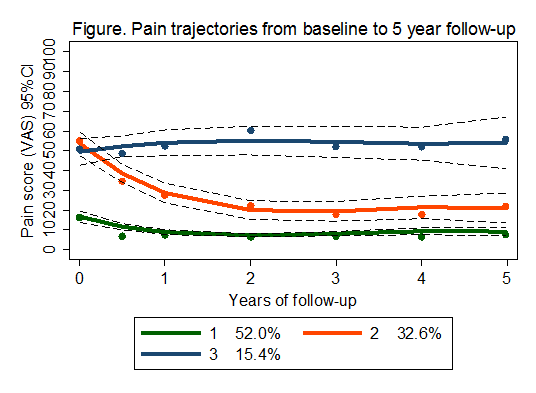Session Information
Session Type: Abstract Submissions (ACR)
· Background/Purpose: Pain is the most common symptom of JIA and has been associated with disease activity. However, disease activity has only accounted for a small amount of the variance in pain. This suggests predictors beyond clinical factors may be important in determining pain. The objectives of this study were to predict, at first presentation, children who are likely to have poor pain outcomes and how these children differ from those that improve.
· Methods: Participants were children with new inflammatory arthritis who were recruited into the CAPS cohort and followed systematically with baseline data for the 100mm visual analogue scale (VAS) for pain available. A two-stage approach was used for the analysis. Firstly, pain trajectories were modelled in children with pain VAS at presentation and at one or more follow-up visits (up to five years post baseline) using a discrete mixture-model. Secondly, multinomial logistic regression was used to determine the association between baseline variables and trajectory groups (95%CI). These variables included the core outcome variables (active and limited joint counts, physician’s global assessment (PGA), parent/patient general evaluation (PGE), childhood HAQ (CHAQ) score), gender, age at onset and disease duration.
· Results: 957 children were included. A three group trajectory model of pain was selected as the most clinically relevant model (Figure) and included a Low-Low pain group (trajectory 1), a High-Low pain group (trajectory 2) and a High-High pain group (trajectory 3). Children in the High-Low group and High-High group had significantly older age at onset, longer disease durations, more involved joints, higher PGE, PGA, pain and CHAQ scores at presentation, compared to children in the Low-Low group. Higher pain at baseline predicted membership of the High-High group (RRR 1.1 (95% CI 1.05, 1.1) and High-Low Pain (RRR 1.1 (95% CI 1.1, 1.1) compared to Low-Low group; and predicted membership in the High-Low group compared to the High-High group (RRR 0.98 (95% CI 0.97, 0.99). Both Higher CHAQ scores and older age at onset predicted membership in the High-High group compared to both the Low-Low group and the High-Low group. Longer disease duration at presentation predicted membership in the High-High group (RRR 1.03 (95% CI 1.01, 1.04) and the High-Low group (RRR 1.02 (95% CI 1.001, 1.03) compared to Low-Low group.
· Conclusion: Even when adjusting for core outcome variables at presentation, participants who present earlier in their disease, are younger at disease onset and report less pain and functional problems upon presentation are less likely to report pain over time. Age at onset, functional problems and pain at presentation differentiated between high levels of pain which improved or persisted over time.
Disclosure:
A. Rashid,
None;
K. Holliday,
None;
L. Cordingley,
None;
R. Carrasco,
None;
B. Fu,
None;
H. E. Foster,
Pfizer Inc,
9,
Abbott Immunology Pharmaceuticals,
9,
Roche Pharmaceuticals,
9,
Novartis Pharmaceutical Corporation,
9;
E. Baildam,
None;
A. Chieng,
None;
J. Davidson,
None;
L. Wedderburn,
None;
K. Hyrich,
None;
W. Thomson,
None.
« Back to 2014 ACR/ARHP Annual Meeting
ACR Meeting Abstracts - https://acrabstracts.org/abstract/predicting-chronic-pain-in-children-with-juvenile-idiopathic-arthritis-results-from-the-childhood-arthritis-prospective-study/

